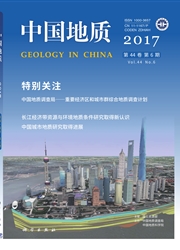

 中文摘要:
中文摘要:
色那铜(金)矿床位于西藏班怒成矿带西段的多龙矿集区内东北部,具有良好的找矿潜力。锆石U-Pb测年显示成矿石英闪长玢岩的形成年龄为(118.1±1.4)Ma,与已报道的多龙矿集区内岛弧型含矿斑岩的成岩成矿时代一致。色那石英闪长玢岩属于活动大陆边缘的高钾钙碱性—钙碱性系列准铝质I型花岗岩,富集轻稀土(LREE)和大离子亲石元素(LILE:Th,U,K及Rb),亏损重稀土(HREE)及高场强元素(HFSE:Nb、Ta、Zr及Ti),δEu为基本无异常(0.92~1.04),具备典型岛弧岩浆岩特征。岩石Rb/Sr值(0.143~0.195),Zr/Hf值(31.23~34.14),Nb/Ta值(9.21~11.59),反映出壳幔混合的特点。锆石(176Hf/177Hf)i为0.282707~0.282719,εHf(t)为0.28~11.77,两阶段模式年龄TDMC=424~1159Ma,暗示其可能起源于新生下地壳的部分熔融。综合分析认为,色那矿区石英闪长玢岩是班公湖—怒江特提斯洋壳向北俯冲于羌塘地块之下的背景下,由新生下地壳部分熔融形成,源区内可能有幔源物质混入。早白垩世晚期(约118.1Ma)班公湖—怒江洋仍然存在向北俯冲消减作用。
 英文摘要:
英文摘要:
Located in the northeast of the Duolong ore concentration area in the Bangong Co-Nujiang metallogenic belt, Tibet, theSena copper (gold) deposit has favorable prospecting potentiality. The quartz diorite porphyrite in the deposit whose zircon U-Pbage is (118.1±1.4) Ma is consistent with the age of reported arc-type ore-bearing porphyry in the Duolong ore concentration area.They belong to high-K calc-alkaline to calc-alkaline and metaluminous I-type felsic rocks. These porphyries are systematicallyenriched in large- ion lithophile elements (LILE such as Th, U, K, Pb and Rb) and LREE, relatively depleted in high strengthelements (HFSE such as Ta, Nb, Ti and Zr) and HREE. And they are slightly rightly-oblique,show the fractionation between LREEand HREE, and display no Eu anomalies (δ Eu= 0.92-1.04). According to the regional tectonic setting, the authors hold that thegeochemical characteristics of the quartz diorite porphyrite are consistent with those of arc- type magmas in the world, and theclosure time of this ocean should be later than early Cretaceous (118Ma). The Rb/Sr ratios (0.143- 0.195),Zr/Hf ratios (31.23-34.14), and Nb/Ta ratios (9.21-11.59) suggest that the melts had characteristics of crust mantle mixing. The zircon (176Hf/177Hf)i, εHf(t)and TDM2 are 0.282707-0.282719, 0.28-11.77 and 424-1159 Ma, respectively, indicating that the rocks probably represent the remeltingproducts of juvenile crust, also impacted by minor mantle- derived mafic melts under the background of northwardsubduction of Bangong Co-Nujiang Tethys to Qiangtang massif.
 同期刊论文项目
同期刊论文项目
 同项目期刊论文
同项目期刊论文
 期刊信息
期刊信息
